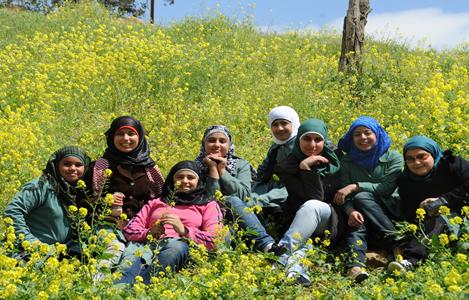|
Alive in Dead Sea
Photograph
by Preeti Verma Lal
"Packing for Jordan ? Isn’t this the summer of discontent in the Middle East ? Isn’t it a rather barmy idea? Isn’t it dangerous to travel now?” Even before I could throw in the Billabongs and flip-flops into my black duffel, a friend rattled off questions like an efficient matron. Her mind was cluttered with images of strife in the region, her ears buzzing with sound of booming guns. If she could, she would have stacked artillery and armour for my trip. Fortunately, god forgot to pack Fear into my petite frame. Fearlessly, I was ready to go to the land where Christ was baptized, where Moses died; the land which is mentioned as the ‘blessed neighbourhood’ in the Holy Quran; the land where the Nabataeans traded, where Cleopatra slathered herself with Dead Sea mud; to the land which has been continuously inhabited since 9500 bc.
On the Royal Jordanian flight were burly marshals with gimlet eyes; at the Amman airport, the breeze was gentle, the passage through immigration cheery and the peace astonishing. Jordan , I learnt hurriedly, was safe. My friend was wrong, I needed no armour in Jordan , I needed no veil. For a while, I needed no gravity, either.
No, the car had not swerved to the gravity-less moon, I was heading to hit a low. Actually, the lowest. For the Dead Sea is the lowest point on earth – it is 430 metres below sea level. That’s the nadir, I muttered. But the highs of the lows were luring me to one of the saltiest water bodies in the world – the Egyptian mummies were embalmed with the Dead Sea mud which is laden with minerals and nutrients; perhaps it was this mud that lent Cleopatra that famed porcelain sheen. I scooped a handful of mud from an earthen pot, sealed each pore, walked down the jetty and dipped my toe in the emerald water. In the sea stood sculpted rocks embellished with salt deposits and far away the silhouette of Israel shimmered in the sunlit haze. I jumped into the Dead Sea and bobbed. Forget Cleopatra, I felt like a mundane cork, bobbling randomly. I thought I was cockamamie till I saw a floating bespectacled man reading a book on the sea as if he were in a pew.
I could have floated forever, but I stuck to the 20-minute limit; the salty sea is so corrosive that staying longer is not advisable. I looked at the calendar, Easter is round the bend. Prompted by Easter, I opted for the Biblical route in Jordan . My piety trek began at Bethany Beyond the Jordan where eons ago lived John the Baptist. The mud track flanked by shrubs led to the actual site of Jesus’ baptism between Tell al Kharrar and John the Baptist Church . I travelled back in time to those three days that Jesus stayed in Bethany – it was here that Jesus was anointed by God, first prayed to God and gathered his first disciples. I looked at the arid terrain and the trickle that River Jordan is and thought of Elijah who is believed to have ascended to heaven in a whirlwind on a chariot of fire. I stood mesmerized, the golden church dome gleamed like jewels against the cobalt sky and the priest in black robe blessed me with a beatific smile.
I was not caught in any celestial whirlwind, but that, however, was not the end of my tryst with divinity. I drove to Madaba, the City of Mosaics , whose pride lies, well, in its mosaics. The masterpiece is housed in the Orthodox Church of Saint George – a 6 th century mosaic map of Jerusalem and the Holy Land , often touted as the earliest religious map of the Holy Land in any form to survive from antiquity. The mosaics have chipped, their colours have faded, but what remains startling is the ingenuity of the ancient craftsmen.
There was so much waiting in Jordan , I wanted to scoot to Petra , one of the wonders of the world, but before that I decided to walk up Mount Nebo , the final station in Moses’ flight from Egypt to the Holy Land . I stood at the windswept promontory overlooking the Dead Sea , the Jordan River Valley , Jericho and the distant hills of Jerusalem and looked at the land where Moses died.
Three days in Jordan and piety was becoming second skin. I was feeling blessed, but a mercenary peeped its head out of the divine dust. I tied a kaffiyeh, rubbed a bucket of sunscreen, laced my shoes and got prepped for a peep into Petra , the nation’s crown jewel. A world wonder, Petra traces its beginnings to the Nabataeans, an industrious nomadic Arab people who turned the city into an important junction for the silk, spice and other trade routes that linked China, India and southern Arabia with Egypt, Syria, Greece and Rome. Petra is a city carved into the sheer rock face with intricate dams, water channels and rooms. Petra is so big that one could spend a lifetime admiring the 2000-year old site, but I just had half a day, so I hurried past jostling crowd to the Treasury, Petra ’s most famous monument, that appears almost dramatically at the end of a long tortuous walk. I sighed by the carved columns, the horses neighed and an old Bedouin generously offered piping hot tea with mint.
I stepped into his sparse cave. In one corner hung a spear, in another a sequined scarf. I slouched on the kilim and the muezzin invoked the Lord. I felt safe. The gods were with me in Jordan ; I needed no Graeco Roman gladiator from Jerash, the ruined Roman city.
The Deccan Herald, 2011
|

